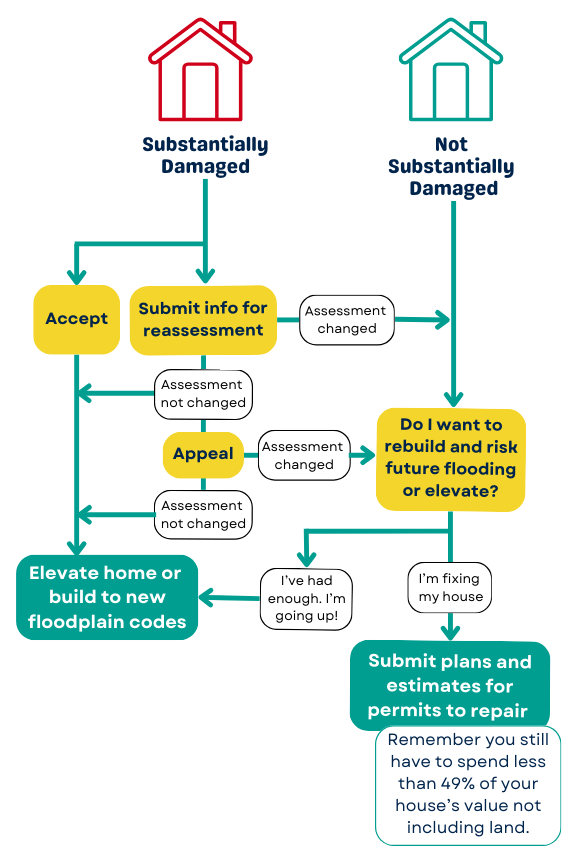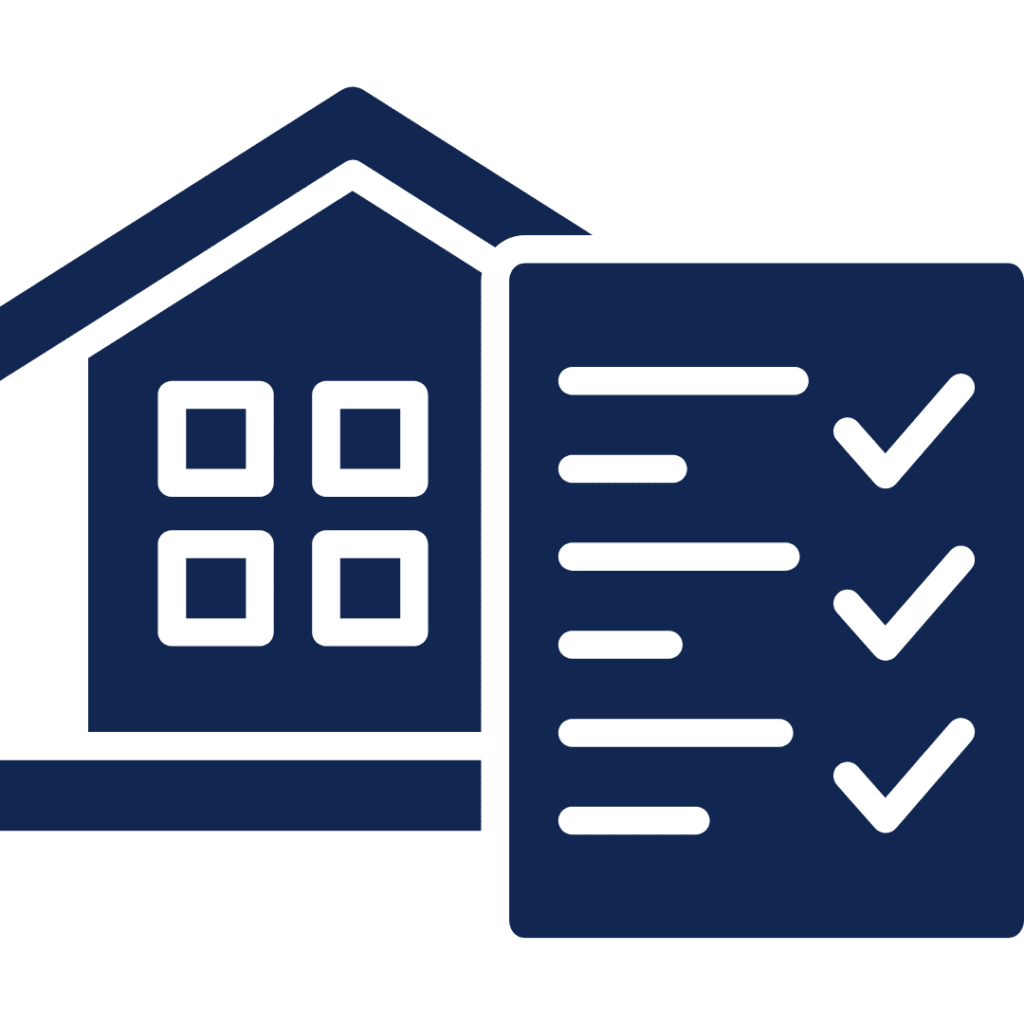Substantial Damage & Storm Permits
Note: Pinellas County Government manages Substantial Damage Assessments for unincorporated areas. If you live within a city, please contact your city for specific information about their Substantial Damage plan and permitting information.
Mobile home residents visit: Mobile and Manufactured Homes Instructions.
Are you a resident in a condo, apartment or townhome? View detailed information on Storm Repairs for Condos, Apartments & Townhomes.
Get Your After-the Fact Permit by June 30, 2026, to Avoid Penalties
If you’ve already started or completed storm-damage repairs without a permit, you may need an after-the-fact permit to stay compliant. Visit pinellas.gov/after-the-fact-permitting to understand the process and complete the required documents. Taking this step now helps avoid fines, protects your property, and keep Pinellas County in good standing with FEMA. Penalties for submitting permits after-the-fact are waived through June 30, 2026. Standard permit fees still apply.
Look up your Substantial Damage Letter
The County is in the process of mailing substantial damage determinations in unincorporated Pinellas County to residents whose homes have experienced substantial damage. Residents can lookup their property address to see if a determination has been made and download their substantial damage letter. Several properties are still awaiting a determination. NOTE: The look up tool only shows results for mailed determinations.
How does the Substantial Damage Rule impact Pinellas County?
We know recovering from two hurricanes is overwhelming. Pinellas County is actively working to help our residents get back on their feet while following guidelines that will protect our community from future harm.
If you live in a flood hazard area and your home was damaged during the hurricanes, your property will be assessed for Substantial Damage.
If the cost to repair the home is 49% or more of its value without the land, the home is considered Substantially Damaged and cannot be repaired without bringing it into compliance with the current floodplain codes (e.g. elevating or replacing it). This is a process that the federal government requires all cities and counties that participate in the National Flood Insurance Program to follow.
Don’t make repairs without a permit
You might have to undo the work at your own expense. Homes outside the flood hazard area or those with only minor damage can apply for permits here. All permits will be reviewed to make sure they comply with the County’s Substantial Damage and Substantial Improvement rules (see details below). For questions, contact Building & Development Review Services at (727) 464-3888. For storm recovery permitting, email buildingpermits@pinellas.gov.
Here’s what you can expect
- The County made a list of homes that were likely to have flooded or where significant damage was reported.
- Inspectors are visiting these homes to document the damage. If no one is there to let them in, they are doing their best from the outside.
- A quality review and assessment are being done to estimate the amount of damage to each home. This should be completed by the end of the year, but many will be done sooner. Property owners will get a letter informing them of the County’s assessment.
- You don’t have to wait for the County to complete the Substantial Damage Assessment if you (1) have a permit ready to file and (2) live in unincorporated Pinellas County. Here are your options…
- If you had minor damage – i.e. less than 12’’ of water and below power outlets – apply for permits now.
- If you had more extensive damage, hire a licensed contractor or submit photos and a detailed repair estimate to bring your home back to pre-storm condition. The County will review the repair estimate vs. structure value to determine if it is considered Substantially Damaged. More info on repair permits in the floodplain.
- Whether your home is determined as Substantially Damaged or not, all improvements are subject to the 49% structure value rule.
The flowchart below shows the options for properties designated Substantially Damaged or not.

Remember: The Substantial Damage rule applies even if you do the work yourself or used donated materials (See items included in Substantial Damage repairs).
What YOU can do if you live in a flood hazard area and your home was damaged…
- Clear out any remaining storm-damaged drywall, contents and materials.
- Look up what you can spend on repairs. Visit pcpao.gov, search for your address and click “FEMA/WLM Letter in the Quick Pick Tool Box on the right. You are allowed to spend up to 49% of the value of the structure (the house, not the land). Make sure to file claims through your insurance. You can also apply for assistance through FEMA, SBA and your NFIP Increased Cost of Compliance Coverage (if you carry this).
- Ask a licensed contractor for an estimate or create your own estimate of the cost to fully repair your home to its pre-storm condition. If you plan to do the work yourself, FEMA requires estimates to include market-rate labor costs.
- Consider the costs vs. benefits of raising your house or building a new house at a higher elevation before deciding whether to pay for repairs.
- If your repair will cost less than 49% of the value of your house without the land, you can apply for permits now, even if you have not received a letter. The County will evaluate your estimate vs. the structure value to determine if it is substantially damaged before they can issue a permit.
- Be patient and contact us with questions: Substantial Damage assessments will take time. If you have questions or concerns while waiting for your home to be inspected, contact us at 727-464-3888 or send email to sdinspection@pinellas.gov.
If you think the property appraiser’s value of your house without the land is not correct:
- Submit a request for a free, pre-storm building value reconsideration to the Property Appraiser’s office.
- If the reconsidered value still seems too low to you, you can pay for an appraisal from a professional property appraiser. Make sure the appraisal follows guidelines at Pinellas.gov/appraisals.
- If either of these approaches shows a value of your home that is high enough to complete the repairs for less than 49% of that value, you can submit an application for a reassessment. If you have a contractor or are ready to apply for repair permits as an owner, you or your contractor may submit your permit application with the materials needed for reassessment all at once using the online permitting system.
Things to consider about rebuilding or elevating your home:
If your home flooded during the recent storms, chances are it will happen again. You will likely receive FEMA disaster assistance and/or insurance payments. Consider investing these in raising your home or replacing it. This will likely increase your property value by more than repairing your home at its current elevation.
SBA.gov is accepting loan applications from homeowners whose primary residence was damaged. Other state and federal funding sources may become available to raise or replace your home, but these may take months or even years to become available.
The 49% rule and your home’s market value
Market value means the value of the building and structures, excluding the land and other improvements on the parcel.
The term refers to the Actual Cash Value (like-kind replacement cost depreciated for age, wear and tear, neglect and quality of construction), determined by a qualified independent appraiser following the Pinellas County Appraisal Checklist, or the “Just Value” of the structure, developed by the Pinellas County Property Appraiser’s Office (PAO) for Ad Valorem taxation purposes, adjusted to approximate market value, as determined by the PAO.
Where can I find the pre-damaged market value of the structure?
- Go to https://www.pcpao.gov
- In the Quick Search area, enter the address and click the search button.
- After the page loads, you should see “Quick Pick Tool” on the right, click “FEMA/WLM Letter”
Costs to Include
Here are some examples of the costs to include when estimating repairs and improvements.
- Materials and labor cost (including donated or discounted materials and owner-or volunteer-completed labor)
- Structural elements
- Demolition and debris disposal
- Contractor overhead or profit
- Utility and service equipment
- Elevation or floodproofing
- Site preparations
- Costs associated with complying with regulations or code requirements
- Interior and exterior finishes
To pass FEMA standards, costs are based on average commercial rates for labor and materials – that means even if you do the work yourself or get your own materials, you must estimate those costs toward the 49% improvements. That’s because the floodplain regulations are intended to make sure long-term improvements to homes and structures can withstand future flooding.
Click here to use the FEMA substantial damage estimator tool.
Property Tax and Substantial Damage/Substantial Improvement
Will my 2024 tax bill be reduced due to damage from Hurricane Debby, Helene or Milton?
Property values and tax bills for the 2024 tax year are based on values as of Jan. 1, 2024. While 2024 tax bills will not be reduced, residential property owners are eligible for a partial property tax refund due to damage associated with a catastrophic event if certain conditions are met. Learn more at the Property Damage (Hurricane or Other Calamity) Information & Resources page on the Pinellas County Property Appraiser’s Office website.
My home flooded due to a Hurricane. Will my property’s assessed value increase if I repair or rebuild my home?
No, as long as the repaired or rebuilt home does not exceed 110% of the structure’s original square footage. Under Florida Law, if a property is damaged or destroyed by misfortune or calamity after the damage or destruction occurs, the property owner may continue the homestead exemption. The calamity provision in Florida Law protects property owners from an increase in their assessed value following a catastrophe when repairing/rebuilding their property up to 110% of their original square footage. The owner must notify the Property Appraiser that they intend to repair or rebuild the property and use the property as the primary residence following the completion of repairs. Learn more at the Storm Damage FAQs page on the Pinellas County Property Appraiser’s Office website.
What should I do if the Structure Value percentage listed on the Property Appraiser’s website (FEMA letter) is lower than what I need to meet FEMA’s repair requirements for my property?
A property owner can hire a private certified appraiser to conduct a retrospective Actual Cash Value appraisal (also known as the ’50 Percent Rule’ appraisal). The structure value presented on the Property Appraiser’s FEMA Letter is one of the two methods allowed by FEMA to obtain the market value (aka Actual Cash Value) of your structure. The purpose of the Property Appraiser’s value estimate is for tax assessment purposes and not for arriving at Actual Cash Value (ACV) of the structure. A retrospective (pre-storm) Actual Cash Value appraisal performed by a state-certified appraiser has a very specific scope of work, intended use/users, includes a detailed interior and exterior inspection, and review of owner-provided documentation that demonstrates the home’s quality and condition before the damage. Therefore, it is not uncommon for an independent ACV appraisal to produce a higher structure value as several of the above-mentioned items are not typically available to the Property Appraiser. A copy of Pinellas County’s Appraisal Review Checklist is available at: https://pinellas.gov/appraisals/. Other jurisdictions (Cities) may have their own review checklist. Learn more at the Request for Pre-Storm Building Value Reconsideration (BVR) page on the Pinellas County Property Appraiser’s Office website.













